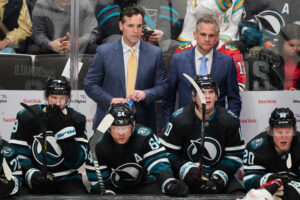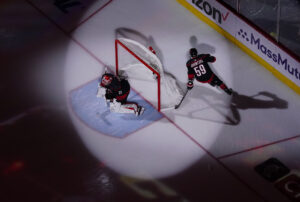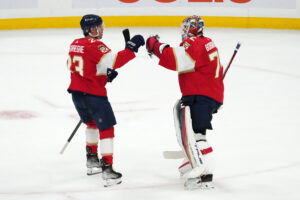With a single move the Florida Panthers brought back hockey’s doubters. The firing of Gerard Gallant has brought back hockey’s most frustrating argument: analytics. It’s the hockey world against the computer boys; traditionalists against the waves of change. The clash of culture between hockey’s long-established thought-process and this new collection of ideas is, at its core, one built on fear, misunderstanding, and an aversion to change.
The most clueless front office in the NHL fires Gerard Gallant as coach Guess the computer boys ran the numbers and it didn’t add up.
— steve simmons (@simmonssteve) 28 November 2016
The most clueless front office in the NHL fired Gerard Gallant. The Panthers should be honoured to have gained such an impressive moniker from one of hockey’s most accomplished antagonists. Is it deserved? No, but we’ve long passed the point where facts are the primary concern for Steve Simmons.
Outside of Dale Tallon and William Torrey, who has been with the Panthers since their inception, the Panthers are under the guidance of a relatively new regime. Eric Joyce, the assistant general manager, and acting-GM has been with the organization since 2013. Steve Werier, AGM and Vice President of Legal Affairs joined at the same time. Brian MacDonald, Director of Hockey Analytics is in his second season with the team.
How are these men responsible for the fate of a team that has made the post-season once in the three years they’ve been there and just four times in the 19 seasons prior? Great question, you’d have to ask Mr. Simmons the answer to that one.
These are the kind of baseless accusations that are often levelled at proponents of the increased use of information in hockey. I didn’t use the word analytics there, because analytics is the analysis of statistics; the interpretation of numbers. These people aren’t just denying the way people analyze them, they’re denying the numbers. These people usually fall into three categories: the fearful, the confused, and the unwilling.
The Fearful
Simmons’ tweet is a great example of what it is to be fearful. The Panthers made a change, which signified going in a direction that he doesn’t understand. One that is counter-intuitive to everything he knows about the sport. To be in a position where it’s your job to be an expert on a sport and to have that sport move in new, unintuitive, ways is frightening. But it doesn’t need to be. The next wave of hockey statistics isn’t complicated, and anyone who puts even a modicum of effort in can learn most of them in an afternoon. There are ideas that are tougher to grasp, and ideas that are simpler, but if you’ve grown up watching hockey these ideas aren’t revolutionary. If anything, they’re the buzzwords you hear parents yell at the rink on weekends; except with stupid names.
The people who are scared of this next wave of numbers are simply those who don’t understand them, who are afraid that by changing the way we view the game we will change the game itself. And that is frightening. The reality is the game is already changing on its own. Players are faster than ever; the focus on technical skills, conditioning, and tactical analysis is higher than ever. Teams are wearing heart monitors in training, optimizing shift length, and limiting minutes. Hockey was always going to adapt. This next wave of ideas isn’t going to change that, but it might challenge those who are slower to adopt these ideas.
The Confused
The next group are those who are confused. Maybe they’ve run into these stats in passing but they don’t really understand them. To be fair them, they aren’t exactly intuitive. Jim Corsi might have been the originator of the idea, but Corsi, and Fenwick aren’t exactly the most user-friendly terms. Credit where it’s due, the NHL did try to change this, using the terms shot-attempts (SAT) and unblocked shot-attempts when they rolled out their redesigned website. Though it sounds clinical, that is what Corsi and Fenwick stand for (Fenwick only counts misses and shots on goal).
There are more in-depth statistics like wins-above-replacement and goals-above-replacement, expected goals, score-venue-zone adjusted metrics, and adjusted metrics, but the creators of these stats have all written explanations for why these adjustments/statistics matter, and how they are formulated. What’s important to note is that you don’t need to be a mathematician to understand them. The math is included, so that these ideas can be peer-reviewed like in the academic world, but for the common fan the explanations alone will suffice.
the guy shouting for a better Corsi For percentage is the same guy in row 317 who yells “shoot” every time his team gains the zone.
These ideas aren’t confusing; they just take a little reading to make sense of. When you boil it down to the basic principles of it all the guy shouting for a better Corsi For percentage is the same guy in row 317 who yells “shoot” every time his team gains the zone. The person who wants his team to take shots with a higher expected-goals value, is the same guy who wants people to drive the net, and crash the crease. The ideas aren’t new; people are just finally trying to find a way to measure them.
The Unwilling
The final group are the unwilling. Those who either have decided they don’t want to understand the numbers, or just don’t care. It’s important to note there is nothing wrong with either of these decisions if you are a fan of the sport. Whether you’re a casual observer, or a die-hard fanatic you don’t need to understand statistics to appreciate the sport. Understand you will have some serious disagreements with those who follow these stats when it comes to player evaluation, but not following them shouldn’t detract from your fandom.
When Unwilling Becomes an Issue
What is an issue is when the people in this category aren’t fans. Whether they’re media, agents, or hockey management, choosing to wilfully ignore the ideas that are shaping the way we examine the game is a detriment to your knowledge, and to your ability to do your job at maximum efficiency. If you are a media member, and you don’t understand why a team is making the moves it makes, how can you be expected to explain them to your readers? If you’re an agent, and you’re player struggles in box-score stats but dominated shot-attempts on a nightly basis how can you get him the best contract? If you’re a member of hockey management and you’re choosing to ignore information that is available to you for free, you’re not doing your job.
As management it’s your task to be as informed as possible, to take everything into consideration so that you can give your team a competitive edge. Sportsnet’s Jeff Marek has a habit: when his coworkers say “hockey analytics” he replaces that word with “fact”. That’s what these numbers are. They are facts, things that happened that we counted, and gave a percentage value to. Now imagine a general manager of a team saying he doesn’t like “facts” because he doesn’t agree with them. If it sounds stupid, it’s because it is. Regardless of whether or not you like a fact, you should still consider it.
The other argument that I see frequently is that “hockey statistics don’t show the whole picture”. This is a very fair critique, but no one has claimed that they do. Choosing to ignore them because they don’t tell you everything is like choosing not to watch game film because it wasn’t in high definition. Yes, the picture might not be as clear, but there is still valuable information in there that you could learn from.
The resistance against this new wave of statistics, particularly from media and management, is one of the most puzzling phenomena in the NHL. At the end of the day, these stats were created by fans trying to discern why the teams they support were struggling. That’s the kind of information a general manager should be begging his team for, not shunning out of some misconstrued aversion to changing the old ways.
Back to Florida
The situation in Florida has highlighted this divide. Two groups are coming about the game from different angles, both hoping for the same end goal. It has resurfaced critiques of statistics that were resolved years ago, and once again begged the question: “do analytics work?” Here’s the thing, hockey has always included analytics. Analytics is just the analysis of statistics. Whether those stats or plus/minus, hits, or goals, we’ve always used analytics to inform our decisions. Why all the sudden have they become the issue? The NHL doesn’t have a problem with analytics. It has a problem with change.
Main Photo






